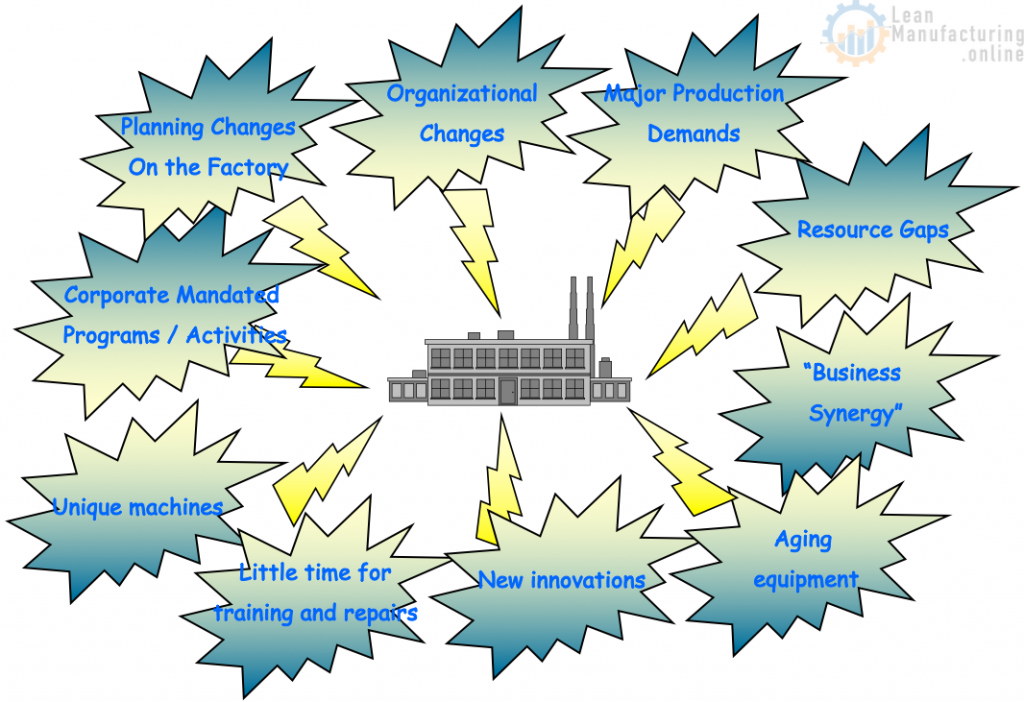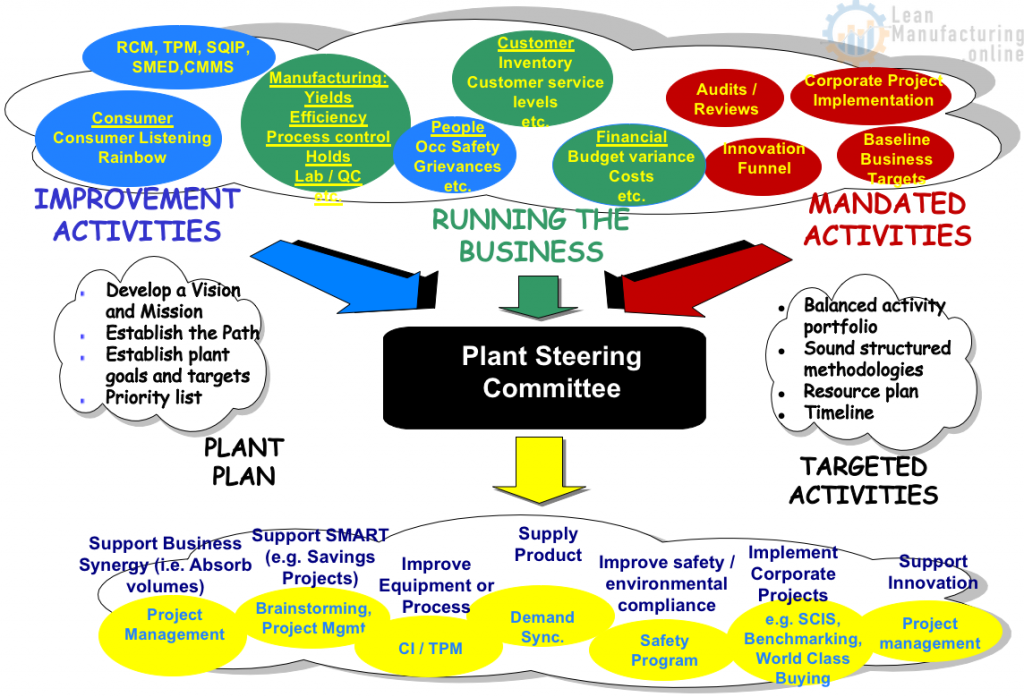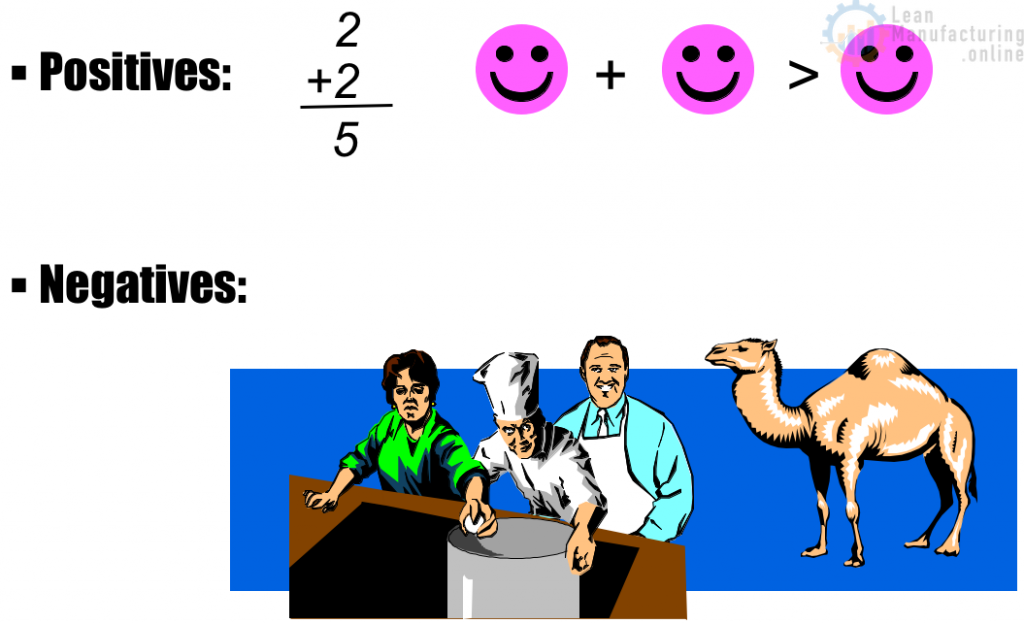Objectives of Steering Committee Training
- To give a functional understanding of how to be an effective team.
- To deliver a clear understanding of the plant Steering Committee and the Pillar Champion Roles & Responsibilities.
- To deliver an understanding of how to set vision, strategy, and goals, as well as how to prioritize opportunities.
- To provide a strong understanding of how business criteria link to TPM pillars.
- To develop a clear understanding of the next steps for the plant Steering Committee and for Central CI.
Escalating Complexity of Plant Management

What we will be doing is turning the plant STAFF into a STEERING COMMITTEE to take control of all these things you have coming at you.
- Develop a Vision, Mission, Strategies, and action plans.
- Use the tools of TPM, including a RESOURCE PLAN
- Keep moving FORWARD
To improve the chances of the site for SURVIVAL in today’s world – more ORGANIZED, more in CONTROL of the plant’s destiny.

How Could Your Team Have Improved Survival Chances?
- Have more information (data)
- Operate more effectively as a team
- Roles & Responsibilities
- Synergies
- Develop a Strategy & Action Plan
The first point – DATA – ties in really well with TPM. DATA is a key focus in TPM – to make GOOD DECISIONS
SYNERGIES – making sure you pull everyone’s BEST together – get everyone’s strengths involved.
That’s part of the VALUE of developing STRATEGIES and ACTION PLAN.
HOW TO BE AN EFFECTIVE TEAM & HOW TO HAVE EFFECTIVE MEETINGS
EFFECTIVE TEAMS: Brainstorm Exercise
Brainstorm – characteristics of teams you have been on – or imagined – what would make a team situation HELL. Record the list on a flip chart.
Synergy: The Biggest Advantage of Teams

So – the great thing about working as a team is SYNERGY, as we mentioned before.
The TEAM is GREATER than the sum of its parts. We need to avoid the negatives of working in groups (some of which are on the Team from Hell list) – we don’t want results to be “Too many chefs spoil the soup.” or “A camel is a horse designed by a committee.”
Just working in a group doesn’t make the results good – you have to be an EFFECTIVE TEAM.
Synergy – Depends On Differences
- Perceptions
- Experience
- Values
- Background
- Working styles
- Levels of detail
- Thinking style
- Interests
People have DIFFERENT PERCEPTIONS & EXPERIENCES that they bring to the team.
What is “playing” in your head is different than what is in others’ heads – they react and process information differently than you do.
Get people to work toward a COMMON GOAL – and the differences will align to that goal – resulting in SYNERGY.
How is Synergy Achieved?
- Clear purpose
- Participation by all
- Listening
- Constructive disagreement
- Open communication
- Trust
- Clear roles and work assignments
- Leadership
- Style diversity accepted
- No domination
- Self-assessment
Result = an Effective Team!
So – this list should be the OPPOSITE of the team from hell.
LISTENING means REALLY listening – not just sitting quietly thinking about what you are going to say next.
You need CONSTRUCTIVE DISAGREEMENT – what do you think makes it constructive? Why do you need it?
Accept DIVERSITY – use differences to get SYNERGY.
SELF ASSESSMENT – the team should periodically do some kind of check-in – “how are we doing”. Can be a formal assessment/score, or just a round-robin. Vs. objectives on track? and vs. HOW you agreed to WORK together.
Team Results

Stages in Team Development

How many people here have seen the STAGES OF TEAM DEVELOPMENT?
These are the typical characteristics of teams at each stage.
Remember, teams can go forward and back within the cycle. A good example is that if a “performing” team gets a new member, or if they are faced with new external pressures, it can throw the team back – and they have to be aware of that and know how to deal with it.
There is information in other training for facilitators that talks about things to do at each stage that will help a team move forward.
Signs Of Trouble
- One member dominates
- The mission is not clear
- Meeting is tense
- Little accomplished
- Disagreements aired in private
- Turf issues
- Critical outsiders are not co-operating
- The leader makes decisions on own
- Trust is low
- Little sharing among team
- Confusion about roles and assignments
- No diversity among members
- The team does not self-assess
These probably look a lot like your Team from Hell list.
Turf – means people with their own agendas.
If you see these things happening on your team, it might be good to take a step back and talk again about
- HOW you want to work together (we will talk about ground rules in the next slides – they help look at the HOW)
- Make sure the GOAL is clearly understood by all.
- Reiterate / review Roles and Responsibilities.
- Or discuss what is going wrong and why. Sometimes there are things going on behind the scenes that if the group understands, they can better deal with them.
Effective Team Meetings: 5 Key Steps
- Establish Meeting Guidelines
- Plan the meeting
- Conduct the meeting
- Issue meeting documents
- Evaluate the meeting
So, we’ve talked about the TEAM itself – how it develops, what characteristics indicate a team that works well together, or is having problems.
Now let’s talk about the TOOLS you can use to be more effective. Is what we talked about before – Self Assessments
Steering Committee Training – Pillar Champion Roles & Responsibilities. Part 2

















